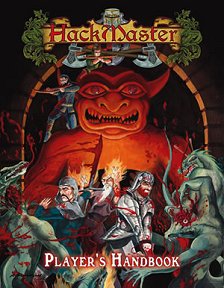Publication history
Kenzer & Company received many requests from fans of the comic to produce an actual HackMaster game, but initially they thought that licensing Dungeons & Dragons would be impossible. In 1999 the Dragon Magazine Archive software was published where Wizards of the Coast failed to get permission to reprint many of the original articles such as the Knights of the Dinner Table comic in the electronic media archive. A contract dispute was settled out of court, they reached an agreement about creating a derivative work, that led to K&C's publication of HackMaster 4th Edition in 2001. As a nod to the fictional version from the comic, this first edition of HackMaster was published as the 4th Edition.
Since its release in 2001, HackMaster has evolved into a full-fledged role-playing game, spawning over forty add-ons, supplements and game aids. Most notable products include a 32-panel gamemaster's shield, a 16-page character sheet and a 10-volume monster encyclopedia. The Hacklopedia of Beasts, the HackMaster version of the Monster Manual, was next released as eight separate volumes. These books were somewhat optional as creature statistics from the 1st and 2nd edition versions of Advanced Dungeons & Dragons (AD&D) were compatible with HackMaster. K&C later released the HackMaster Field Manual, which contained the more popular Hackmaster creatures in a single volume.
Whereas Wizards of the Coast overhauled the rules for 3rd edition D&D, Kenzer & Company took the opposite action by revising the AD&D First and Second Edition rules (including various supplements such as 1st Edition Unearthed Arcana and Oriental Adventures and the mid-1990s Skills & Powers supplements) into a more coherent system and adding an element of parody. In part of that ability to use AD&D rules, K&C was required to maintain a higher level of humor than in the Knights of the Dinner Table comic for products that are revised from previous AD&D material. [1] Completely original works for HackMaster are not subject to this restriction imposed by Wizards of the Coast.
In 2002, HackMaster won the Origins Award for Game of the Year 2001. [2]
The first rulebook for the new edition, HackMaster Basic, was sent out to preorderers on June 19, 2009. HackMaster Basic was created due to Kenzer's licensing for AD&D running out. The title is a nod to the Dungeons and Dragons Basic Set, although HackMaster Basic was re-written so as to not contain any copyrighted material from Wizards of the Coast.
The game includes an official player's handbook, an alternate campaign setting changed from Garweeze Wurld to Kingdoms of Kalamar, a comprehensive, one-volume bestiary called the Hacklopedia of Beasts, and a GM's guide. Also provided are a pantheon of gods and attendant rituals and spells for the cleric class to choose from. [3]
Setting
In 4th edition, the official setting of HackMaster was Garweeze Wurld, a giant continent on the planet Aldrazar based on the notes of Jolly Blackburn. This has been developed in the Garweeze Wurld Atlas and Garweeze Wurld Gazetteer. Garweeze Wurld is about eight thousand miles across, circling much of the northern hemisphere of its planet. The continent is mapped based on forty-eight "sectors", each one thousand miles across. The continent reaches from the tropical band of Aldrazar to its Arctic Circle. The name Garweeze Wurld was a play on the name of the fictional creator of HackMaster in Knights of the Dinner Table, Gary Jackson, who is himself a parody of both D&D co-creator Gary Gygax and Steve Jackson of Steve Jackson Games.
In the 5th edition of the game, the setting has been switched to Kenzerco's "Kingdoms of Kalamar" (KoK) setting. KoK was originally developed as a D&D setting, and has been detailed in several supplements and adventures. Developers for Kenzerco have stated on their forums that the world will not be significantly altered for HM 5th.
This page is based on this
Wikipedia article Text is available under the
CC BY-SA 4.0 license; additional terms may apply.
Images, videos and audio are available under their respective licenses.
